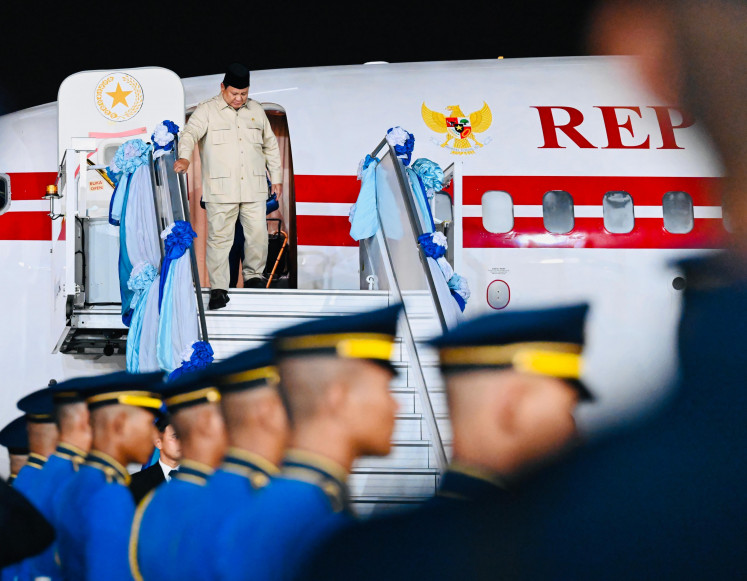Popular Reads
Top Results
Can't find what you're looking for?
View all search resultsPopular Reads
Top Results
Can't find what you're looking for?
View all search resultsChinese temples prepare for New Year
Men and women rolled up their sleeves, wrapped red bandannas around their heads and picked up bucket, brushes and other supplies for the annual pre-new year’s cleaning of one of Bali’s most interesting places of worship
Change text size
Gift Premium Articles
to Anyone
Men and women rolled up their sleeves, wrapped red bandannas around their heads and picked up bucket, brushes and other supplies for the annual pre-new year’s cleaning of one of Bali’s most interesting places of worship.
Budha bless you: A man cleans the face of a Buddha statue Tuesday at Griya Kongco Dwipayana in southern Denpasar. The temple’s custodians cleaned up the temple to prepare for the oncoming celebration of Imlek. (JP/ Zul Trio Anggono )
There are hundreds of Buddha statues in the Griya Kongco Dwipayana Chinese Temple on Jl. Bypass Ngurah Rai in Tanah Kilap, Denpasar, and all of them must be cleaned before the welcoming of the Chinese New Year next Monday.
“The philosophy behind cleaning our statues and temples is that as we welcome a new year, we must also renew ourselves,” Ida Bagus Adnyana, high priest of Griya Kongco Dwipayana, said Tuesday.
“We must start over clean, just like the statues in this temple,” Adnyana said.
The cleaning ritual is one of the most important pre-Chinese New Year traditions.
In Griya Kongco Dwipayana, which houses many beautifully-adorned Buddhists statues, this means a lot of cleaning.
From the familiar figure of a sleeping Buddha to the statues of seven goddesses which stood on top of a pond, Griya Kongco Dwipayana adherents will spend hours, if not days, cleaning these statues in preparation for the influx of Chinese New Year celebrants.
“We just began today actually and this will probably take all day and tomorrow,” the high priest said.
Griya Kongco Dwipayana is one of the most unique worshipping places in Indonesia, as at this one site gather believers from three faiths: Taoist, Buddhist and Hindu
This combination is a remnant of Indonesia’s draconian past, when Chinese people were not allowed to observe their important holidays in public.
In effect, Chinese people secluded their celebrations in relatively small areas while keeping their number of temples low.
This only changed eight years ago, when the administration of President Abdurrahman “Gus Dur” Wahid lifted the restrictions on Chinese celebrations.
Adnyana said the building of the Griya Kongco Dwipayana temple was in itself a miracle, as it lies on a mangrove forest.
“That’s in accordance with the instructions I received in my dream more than 20 years ago,”
Adnyana said.
The high priest had asked for a 16 square meter space. Unexpectedly, the Ministry of Forestry gave him 400 square meters.
In the 1990s, the ministry granted more space, bringing the total area to 900 square meters.
Now Griya Kongco Dwipayana is one of the most popular Chinese temples in Indonesia, drawing devotees from as far away as Manado, Surabaya and Jakarta.
As Chinese New Year grows nearer, Griya Kongco adherents will adorn the temple with red lanterns, decorated umbrellas and banners.
A Chinese Barongsai lion and dragon dance has also been scheduled.
Both devotees and non devotees are welcomed to experience the grandeur of the celebrations.










